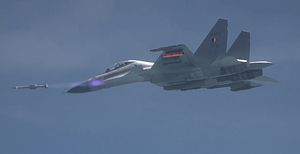An Indian Air Force (IAF) Sukhoi Su-30MKI multirole air superiority fighter has test fired the country’s first domestically designed and developed beyond visual range air-to-air missile (BVRAAM), designated Astra, as part of ongoing user trials off the coast of Odisha in eastern India on September 16.
According to the Indian Ministry of Defense (MoD), the missile successfully destroyed its test target. “The live aerial target was engaged accurately demonstrating the capability of first indigenous air-to-air missile,” the MoD said in a press statement.
“The mission profile was executed in a text book manner,” the MoD added. “Various radars, electro-optical tracking system (EOTS) and sensors tracked the missile and confirmed its engagement with target.”
The Astra BVRAAM is expected to be officially inducted by the end of 2019. Limited serial production of the Astra BVRAAM began already in 2017. Pre-induction trials of the missile system were successfully completed in October 2018 at the Integrated Test Range (ITR) in Balasore.
I previously laid out the technical details of the homegrown BVRAAM:
With a speed of Mach 4.5, the missile’s maximum range when fired from an altitude of 15,000 meters is about 110 kilometers, which is reduced to about 44 kilometers when launched at an altitude of 8,000 meters. Fitted with a high-explosive pre-fragmented warhead, the missile uses an inertial guidance system with an active radar seeker with a homing range of 25 kilometers.
According to Indian media reports, a number of Astra missiles have been fitted with an Indian Ku-band active radar seeker developed by India’s Defense Research and Development Organization’s (DRDO) Research Center Imarat (RCI) in Hyderabad replacing a similar Russian-made product.
A total of 27 test launches have so far been carried out, according to the Indian MoD. The first test launch from a Sukhoi Su-30MKI took place in 2014.
The Astra BVRAAM will be integrated with the IAF’s fleet of Su-30MKI. The IAF fleet of Su-30MKIs is currently composed of around 200 operational aircraft. As of December 2018, HAL has manufactured 202 Su-30MKI fighter jets in India, while the first 50 aircraft were built in Russia and delivered to the IAF in fly-away condition. The IAF is slated to deploy 272 Su-30MKI aircraft by 2021 grouped into 14 squadrons.
As I wrote in May 2018:
The twin-seater, twin-engine Su-30MKI, developed by Russian aircraft maker Sukhoi and license-built in India, constitutes the backbone of the IAF. While the first 50 Su-30 aircraft were built in Russia, the remaining fighter jets were assembled in India. The IAF originally received the older Su-30MK variant from Russia, which the Indian defense industry in partnership with Russian defense companies upgraded to the MKI standard.
Unlike the Russian Su-30SM, the MKI version includes Israeli and French avionics. For example, the aircraft is fitted with a French-made heads-up display system, and an Israeli electronic warfare system and an advanced targeting pod. The Su-30MKI also features AL-37FP thrust-vectoring engines and canard foreplanes for increased maneuverability. HAL and Sukhoi are currently negotiating a contract for the upgrade of older Su-30MKI models in service with the IAF.
The IAF plans to upgrade its fleet of SU-30MKI to “Super Sukhois,” which includes fitting the aircraft with new long-range, precision-strike weapons systems, upgraded engines, and more advanced avionics.
DRDO is reportedly also working on an extended-range variant of the Astra, designated MK 2, with a range of approximately 300 kilometers.
































